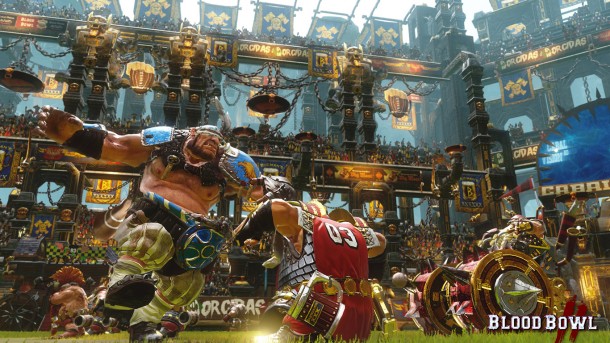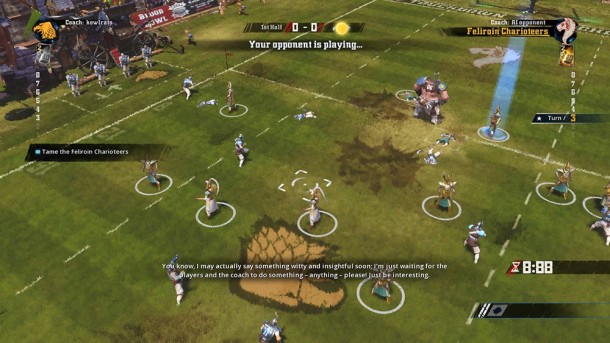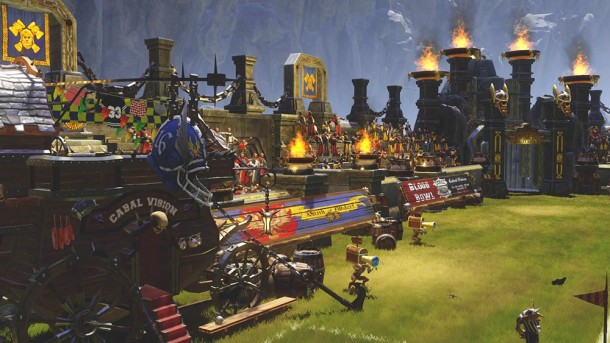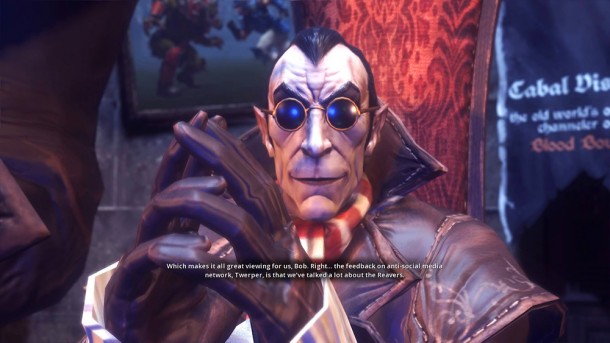I’m in the 6th match of my league, proudly in second place. I’m tied 1-1 going into turn 15 of the game. I have the ball in the hands of my fastest player in the opponent’s half of the field. Life is good. Life is really good.
And then the ref comes over and kicks my player, knocking the ball out of his hands and into those of the awaiting opponent nearby. Life is not so good. But that’s what I get for not bribing the referee ahead of time. That’s the chaos that is Blood Bowl II; it’s based on as much randomness as it is on our practiced skills. It’s huge, it can be frustrating, it can be difficult and it can be rewarding. But I can’t go much further in describing what Blood Bowl II is until I explain what Blood Bowl II isn’t.
Blood Bowl II isn’t a football game.

Blood Bowl II is a table-top game. And an RPG. And Battle Chess.
Set in the popular table-top and media franchise of Warhammer, BB2 pits players against each other as they command a team of characters and creatures from the IP. It’s turn-based, with a heavy focus on strategy and tactics. Much like other table-top games, multiplayer is what the game is really designed for, though there are several single-player modes.
With “blood” in the title, it’s interesting that the majority of the time there isn’t very much action or blood in the experience at all — we’re tasked with thinking several moves ahead before we even make our first in each turn. In fact, like chess, the best of us will plot and plan and rotate the playing field examining possible scenarios in our heads. This can at times lead to a long wait in between the game’s 16 turns, and if it isn’t for the 3 minute clock (which is still rather lengthy) then matches would take hours to end. In the case of an untimed match it can feel excruciating, as the AI opponents seem to take far too long to decide on what to do next and I often wish I could speed things up.

But that’s just a minor part of the experience. Much like a tabletop RPG, BB2 feels like we’re playing against our friends in heated combat while an experienced Dungeon Master maintains the world around us. Even online games contain some intriguing story elements, flavoring the matches with small narratives.
As the characters engage they attack and fight, run and dodge, score and get killed. Because of the tabletop backbone of the game, there’s an element of randomness that can be helpful or destructive for either player. With dice rolls deciding the results of our moves, a giant ogre might seem like a sure thing against a skinny elf except for that one damned time when the ogre ends up a victim in a failed attack, dropped into the graveyard of the sidelines. Runners can be tackled or even trip over their own feet, though at least the game lets us see the percentages of those happening, something that the first Blood Bowl didn’t do. Seemingly arbitrary incidents might take place that involve things like the above mentioned referee attacking me, or my opponent somehow preparing for the kickoff just moments before me, giving them enough time to recalibrate their positioning on the field for better results. There’s absolutely nothing like your receiver running with the football towards the end zone for a score, only to trip and fall on his own just at the end, KO’ing himself for the rest of the match.
It can be a bit infuriating.
But as much as the game can pin us down with its unevenness it can get our blood pumping with adrenaline. The momentum shift can be quick; thanks to a novel “turnover” system, if an attacking character loses the ball or fails in their move, their turn immediately ends and the opponent takes over. This can be extremely helpful, as it can breathe new life into a stalling push towards the end zone. Sometimes that ogre getting knocked down will be my opponent’s, and not only will a hole open up for my players to run through but the ogre might get stunned into another turn. That pushes me to send my team on to the offensive, knocking down lineman left and right and getting far enough ahead to run into the end zone for a score.

Even with the randomness, mastering the strategy within the game is of utmost importance. Learning defensive positions can prevent opponents from attacking ball carriers (or minimize the effect). Triangle positions, teams of two, “arrows” and “shields” and countless more maneuvers can and should be implemented in order to control the battlefield. One thing that helps me plan my moves is to sketch them onto a sheet of paper, using actual X’s and O’s and dotted lines.
Blood Bowl II isn’t a football game. It’s a football manager simulator.
This extends to the pre- and post-match aspects of the game. Player stats can be improved, stadiums upgraded and sponsors signed, all so that we get slight advantages in the matches. Based on how we play fans will support or deny us, affecting us in numerous ways, and it’s up to us to keep them cheering.
This is all learned through the game’s single-player campaign, which acts as a fantastic tutorial. Not only does the campaign feature a narrative of team redemption but it smartly introduces all the aspects of the “regular” experience gradually. For example, during one part of the campaign our players are regularly becoming burger under the feet of enemies, so the game introduces the Apothecaries to teach us about healing. With specific tasks required to progress in some instances, failure can result in us having to restart matches over and over again until we finally complete them. The repetition is tedious, and without the ability to skip matches failure is not an option. Ugh.

The real meat of the game is its multiplayer, and that’s what the campaign sets us up for. Online play includes leagues, friendly matches, and a variety of tournaments. There is no shortage in players, too, and the community is thriving with message boards full of strategies and leagues.
This is all wrapped in the usual crazy Warhammer atmosphere. The visuals are great, the two announcers drop some great one-liners, and the presentation is clean and smooth. The battle cutscenes, even though they repeat often, are still enjoyable and at least they’re fairly quick. Tiny text on the screen is the only thing that irks me, but it’s not necessary to read it to proceed.
Blood Bowl II isn’t a football game, it’s… well, okay — it’s kind of a football game.
It’s a simulation of what I imagine I sound like every Sunday afternoon after my NFL team loses, yelling and screaming and blaming everything and everyone. “He’s cheating,” or “the refs are paid off,” or “why can’t you hold onto the stupid ball?” It has a lot more violence, knockouts and Orcs than the NFL does, too.
Though the unevenness holds the game back a bit, it can often make match outcomes unpredictable even between a novice and a hardened veteran, so we go in thinking we always have a chance. Blood Bowl II is leaps and bounds improved over its predecessor, focusing less on the sports side and more on the appreciated table-top aspects. It’s a satisfying experience, with a surprisingly great campaign and heated online battles.
Even if it feels like the dungeon master hates me sometimes.
This review is based on a PlayStation 4 PSN code sent to SideQuesting by the publisher



No Comments